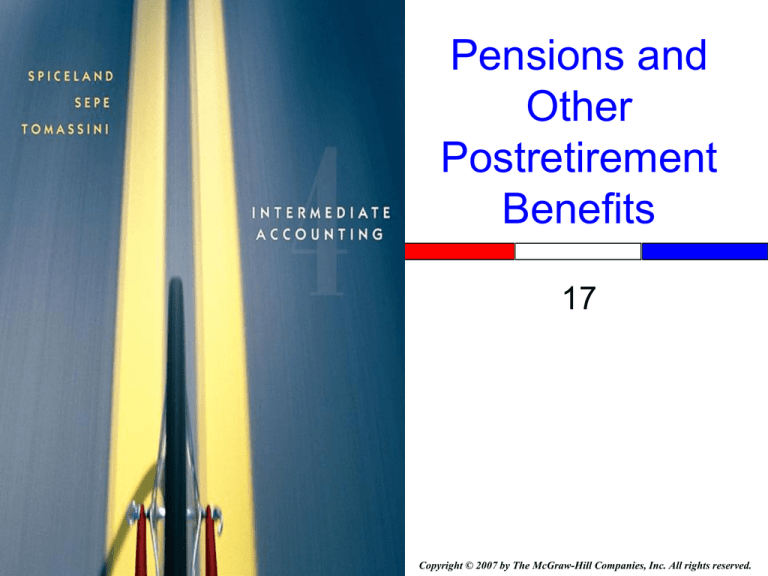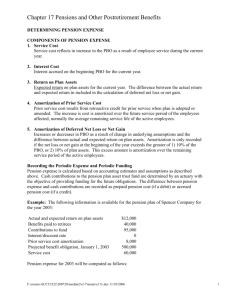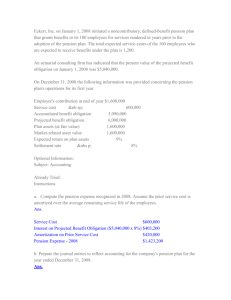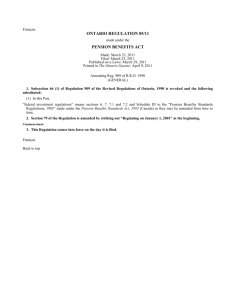
Pensions and
Other
Postretirement
Benefits
17
Copyright © 2007 by The McGraw-Hill Companies, Inc. All rights reserved.
17-2
Nature of Pension Plans
I agree to make payments
into a fund for future
retirement benefits for
employee services.
Sponsor
I am the employee for
whom the pension plan
provides benefits.
Participant
17-3
Nature of Pension Plans
1.
2.
3.
4.
5.
For a pension plan to qualify for special tax
treatment it must meet the following
requirements:
Cover at least 70% of employees.
Cannot discriminate in favor of highly
compensated employees.
Must be funded in advance of retirement through
a trust.
Benefits must vest after a specified period of
service.
Complies with timing and amount of contributions.
17-4
Nature of Pension Plans
The right to receive earned pension
benefits vest (vested benefits) when it is
no longer contingent on continued
employment.
17-5
Learning Objectives
Explain the fundamental differences between a
defined contribution pension plan and a
defined benefit pension plan.
17-6
Defined Contribution
Plans
Contributions are
established by
formula or
contract.
Employer deposits
an agreed-upon
amount into an
employee-directed
investment fund.
Employee
bears all risk of
pension fund
performance.
17-7
Defined Contribution Pension Plans
Defined contribution pension plans are
becoming increasingly popular vehicles for
employers to provide retirement income without
the paperwork, cost, and risk generated by the
more traditional defined benefit plans.
These plans promise defined periodic contributions to a
pension fund, without further commitment regarding
benefits at retirement.
17-8
Defined Contribution Pension Plans
Accounting for these plans is quite simple. Let’s assume
that an annual contribution of employee salaries is to be
4% of gross earnings. If employees earned $10,000,000 in
salaries during the period, the company would make the
following entry:
GENERAL JOURNAL
Date
Description
Pension Expense
Cash
($10,000,000 × 4% = $400,000)
Debit
Credit
400,000
400,000
17-9
Defined Benefit
Pension Plans
Employer is
committed to
specified
retirement
benefits.
Retirement
benefits are based
on a formula that
considers years of
service,
compensation
level, and age.
Employer bears
all risk of
pension fund
performance.
17-10
Defined Benefit Plan
Pension expense is measured by
assigning pension benefits to periods
of employee service as defined by the
pension benefit formula.
A typical benefit formula might be:
1% × Years of Service × Final year’s salary
So, for 35 years of service and a final salary of $80,000,
the employee would receive:
1% × 35 × $80,000 = $28,000 per year
17-11
Learning Objectives
Distinguish among the vested benefit
obligation, the accumulated benefit obligation,
and the projected benefit obligation.
17-12
Defined Benefit Plan
You go to work for Matrix, Inc. on 1/1/07. You are eligible to participate
in the company's defined benefit pension plan. The benefit formula is:
×
×
Annual salary in year of retirement
Number of years of service
1.5%
Annual retirement benefits
You are 25 years old when you start work and will accumulate 40 years
of service before retiring at age 65. If your salary is $200,000 during
your last year of service, you will receive the following annual benefits:
$200,000
×
40
×
1.5%
$120,000
You are not required to make any contributions. The plan vests at the
rate of 20% per year. The plan actuary estimates that upon reaching
age 65, you will receive payments for 15 years. The actuary uses an
8% discount rate in all present value computations.
17-13
Defined Benefit Plan
At December 31, 2007, the end of your first year of service, the
actuary must calculate the present value of the pension benefits
earned by you during 2007. Remember that you will not receive
pension benefits until you are 65 and the actuary estimates
payments will be made for 15 years after you retire. After one year
of service you will have earned $3,000 in pension benefits:
Pension benefits = .015 × 1 yr of service × $200,000
Pension benefits = $3,000
Service cost is the present value of these benefits and is calculated
as follows:
Service cost = $3,000 × 8.559481 × .0497132
Service cost = $1,277
1Present
value of an ordinary annuity at 8% for 15 years.
2Present value of $1 at 8% for 39 years.
17-14
Pension Obligation
Based on the given information, the actuary calculates
your Accumulated benefit obligation (ABO) as follows:
Retirement benefits = .015 × 1 yr × $25,000
Retirement benefits = $375
ABO = $375 × 8.55948 × .049713
ABO = $160
Your Vested benefit obligation (VBO) is calculated as
follows:
Vested benefits = .015 × 1 × $25,000 × .2
Vested benefits = $75
VBO = $75 × 8.55948 × .049713
VBO = $32
17-15
Pension Obligation
The Projected benefit obligation (PBO) differs from the ABO by
using your salary projected at retirement rather than your
current salary. The actuary calculates your Projected benefit
obligation (PBO) as follows:
Retirement benefits = .015 × 1 yr × $200,000
Retirement benefits = $3,000
PBO = $3,000 × 8.55948 × .049713
PBO = $1,277
17-16
Pension Obligation
A reconciliation of the VBO, ABO and PBO would look like this:
VBO
Non-vested benefits
ABO
Adjustment for future salary
PBO
$
32
128
$
160
1,117
$ 1,277
17-17
Pension Obligation
Present value of
additional benefits
related to projected
pay increases.
Projected Benefit
Obligation
Present value of
nonvested benefits
at present pay
levels.
Present value of
benefits at present
pay levels.
Accumulated
Benefit Obligation
Vested Benefit
Obligation
17-18
Learning Objectives
Describe the five events that might change the
balance of the PBO.
17-19
Projected Benefit Obligation
The PBO changes as a result of:
Cause
Service Cost
Interest Cost
Prior Service
Cost
Loss or Gain on
PBO
Retiree Benefits
Paid
Effect
+
+
+
+ or -
Frequency
Each period
Each period (except the first period of
the plan)
Only if the plan is amended (or initiated)
that period
Whenever revisions are made in
assumptions used to estimate the
pension liability
Each period (unless no employees have
yet retired under the plan)
17-20
Pension Obligation
The PBO changes as a result of:
Cause
Service Cost
Effect
+
Frequency
Each period
Each period (except the first period of
Interest
Cost
Service
cost
+ is the increase
the plan)in the
Prior
Service
the plan is amended
(or initiated)
PBO
attributableOnly
toif employee
service
Cost
+
that period
performed
during
the
period.
Loss or Gain
on
Whenever
revisions
are made in the
PBO
+ or pension liability estimate
Retiree Benefits
Each period (unless no employees have
Paid
yet retired under the plan)
17-21
Pension Obligation
The PBO changes as a result of:
Cause
Service Cost
Effect
+
Frequency
Each period
Each period (except the first period of
Interest Cost
+
the plan)
Prior Service
Only if the plan is amended (or initiated)
Interest cost
is the interest
on the
Cost
+
that period
Loss or Gain on
Whenever
revisions are made in the
PBO during
the period.
PBO
+ or pension liability estimate
Retiree Benefits
Each period (unless no employees have
Paid
yet retired under the plan)
17-22
Pension Obligation
The PBO changes as a result of:
Cause
Service Cost
Effect
+
Frequency
Each period
Each period (except the first period of
Interest Cost
+
the plan)
Prior Service
Only if the plan is amended (or initiated)
Cost
+
that period
Loss or Gain on
Whenever revisions are made in the
Prior
result
from
PBO service
+ or -cost effects
pension liability
estimate
Retiree changes
Benefits
Eachpension
period (unlessbenefit
no employees have
in the
Paid
yet retired under the plan)
formula or plan terms.
17-23
Pension Obligation
The PBO changes as a result of:
Cause
Service
Costor
Loss
Effect
Frequency
+ on PBO results
Each period
gain
from
Each period (except the first period of
Interest
Cost revisions of estimates used
required
+
the plan)
Prior Service to determine
Only if the plan
is amended (or initiated)
PBO.
Cost
+
that period
Loss or Gain on
Whenever revisions are made in the
PBO
+ or pension liability estimate
Retiree Benefits
Each period (unless no employees have
Paid
yet retired under the plan)
17-24
Pension Obligation
The PBO changes as a result of:
Cause
Service Cost
Effect
+
Frequency
Each period
Each period (except the first period of
Interest Cost
plan)the
Retiree+benefits paidtheare
Prior Service
Only if the plan is amended (or initiated)
result of paying
benefits
retired
Cost
+
thatto
period
Loss or Gain on
Whenever revisions are made in the
employees.
PBO
+ or pension liability estimate
Retiree Benefits
Each period (unless no employees have
Paid
yet retired under the plan)
17-25
Learning Objectives
Explain how plan assets accumulate to provide
retiree benefits and understand the role of the
trustee in administering the fund.
17-26
Pension Plan Assets
Pension plan assets (like the PBO) are not
specifically reported in the balance sheet.
A trustee manages the pension plan assets.
17-27
Pension Plan Assets
Plan assets change as (a) the investments generate
dividends, interest, capital gains, etc., (b) additional
cash contributions are added by the employer, and
(c) payments are made to retired employees.
Assume the following balances and changes for
Matrix: ($ in millions)
Plan assets at the beginning of 2007
Return on plan assets (10% × $450)
Cash contributions
Less: Benefits paid to retirees
Plan assets at the end of 2007
$
$
450
45
160
(55)
600
17-28
Learning Objectives
Describe the funded status of pension plans
and how that amount is reported.
17-29
Funded Status of the Pension Plan
OVERFUNDED
Market value of plan
assets exceeds the
actuarial present value
of all benefits earned by
participants.
UNDERFUNDED
Market value of plan
assets is below the
actuarial present value
of all benefits earned by
participants.
17-30
Funded Status of the Pension Plan
Projected Benefit Obligation (PBO)
- Plan Assets at Fair Value
Underfunded / Overfunded Status
This amount is reported in the balance
sheet as a Pension Liability if
underfunded or a Pension Asset if
overfunded.
17-31
Learning Objectives
Describe how pension expense is a composite
of periodic changes that occur in both the
pension obligation and the plan assets.
17-32
Pension Expense – An Overview
Components of Pension Expense
+
Service cost ascribed to employee service this period
+
Interest accrued on pension liability
Expected return on plan assets
+
Amortized portion of Prior Service Cost
+ or - Amortization of Net Loss or Net Gain
=
Pension expense
17-33
Pension Expense
Actuaries have determined that Matrix, Inc.
has service cost of $150,000 in 2007 and
$155,000 in 2008.
We can begin the process of determining
pension expense for the company.
17-34
Service Cost
1. Service Cost
2007
$ 150,000
2008
$ 155,000
Total Pension Expense
$ 150,000
$ 155,000
17-35
Interest Cost
Interest cost is the growth in PBO
during a reporting period due to the
passage of time.
Interest cost is calculated as:
PBOBeg × Discount rate
17-36
Interest Cost
Actuaries determined that Matrix, Inc.
had PBO of $500,000 on 1/1/07, and
$640,000 on 1/1/08.
The actuary uses a discount rate of 10%.
17-37
Interest Cost
1. Service Cost
2. Interest Cost
2007
$ 150,000
50,000
2008
$ 155,000
64,000
Total Pension Expense
$ 200,000
$ 219,000
2007: PBO 1/1/07 $500,000 × 10% = $50,000
2008: PBO 1/1/08 $640,000 × 10% = $64,000
17-38
Return on Plan Assets
Actual
Return
Expected
Return
The dividends, interest,
and capital gains
generated by the fund
during the period.
Trustee’s estimate of
long-term rate of
return.
17-39
Return on Plan Assets
The plan trustee reports that plan
assets were $450,000 on 1/1/07,
and $600,000 on 1/1/08.
The trustee uses an expected return
of 9% and the actual return is 10%
in both years.
17-40
Return on Plan Assets
2007
Beginning value of plan assets
Rate of return
Return on plan assets
Beginning value of plan assets $ 450,000
Adjustment (10% - 9%)
1%
Adjusted for gain on plan assets
Expected return on plan assets
$
$
450,000
10%
45,000
4,500
40,500
2008
Beginning value of plan assets
Rate of return
Return on plan assets
Beginning value of plan assets $ 600,000
Adjustment (10% - 9%)
1%
Adjusted for gain on plan assets
Expected return on plan assets
$
$
600,000
10%
60,000
6,000
54,000
17-41
Return on Plan Assets
1. Service Cost
2. Interest Cost
3. Return on Plan Assets
2007
$ 150,000
50,000
(40,500)
2008
$ 155,000
64,000
(54,000)
Total Pension Expense
$ 159,500
$ 165,000
17-42
Amortization of Prior Service Cost
Prior service cost (PSC) results from plan
amendments granting increased pension
benefits for service rendered before the
amendment.
PSC is the present value of the retroactive
benefits and increases PBO by that amount.
17-43
Amortization of Prior Service Cost
Benefits attributable to prior service are
assumed to benefit future periods by:
Improving employee productivity.
Improving employee morale.
Reducing turnover.
Reducing demands for pay raises.
17-44
Amortization of Prior Service Cost
PSC is amortized over the
remaining service period of those
employees active at the date of the
amendment who are expected to
receive benefits under the plan.
17-45
Amortization of Prior Service Cost
Two approaches to amortizing PSC:
Straight-line method
Amortize PSC over the average remaining
service period.
Service method
Amortize PSC by allocating equal amounts to
each employee’s service years remaining.
17-46
Amortization of Prior Service Cost
Effective 1/1/08, Matrix, Inc. amends the retirement
plan to provide increased benefits attributable to
service performed before 1/1/03, for all active
employees.
The present value of the increased benefits (PSC) at
1/1/08, is $60,000.
The average remaining service life of the active
employee group is 12 years.
17-47
Amortization of Prior Service Cost
Since the amendment was not effective
until the beginning of 2008, pension
expense for 2007 is not affected.
2008: $60,000 PSC ÷ 12 = $5,000
17-48
Amortization of Prior Service Cost
2007
2008
1. Service Cost
$ 150,000 $ 155,000
2. Interest Cost
50,000
64,000
3. Expected Return on Plan Assets
(40,500)
(54,000)
4. Amortization of PSC
0
5,000
Total Pension Expense
$ 159,500
$ 170,000
17-49
Gains and Losses
Higher than
Expected
Lower than
Expected
Projected
Benefits
Obligation
Return on
Plan Assets
Loss
Gain
Gain
Loss
17-50
Corridor Amount
Amortization is not required if the net
unrecognized gain or loss at the
beginning of the period is a minimum
amount (corridor amount).
17-51
Corridor Amount
The corridor
amount is 10% of
the greater of . . .
PBO at the
beginning of the
period.
Or
Fair value of plan
assets at the
beginning of the
period.
17-52
Gains and Losses
If the beginning net unrecognized gain or
loss exceeds the corridor amount,
amortization is recognized as . . .
Net unrecognized gain or loss
Corridor
—
at beginning of year
amount
Average remaining service period of active employees
expected to receive benefits under the plan
17-53
Gains and Losses
There was no gain or loss amortized in 2007.
Amounts at January 1, 2008
PBO
Fair value of plan assets
Net gain for 2008
Average service life
$ 640,000
600,000
76,000
12
Let’s determine the amortization of the
net gain in 2008.
17-54
Gains and Losses
Net gain for 2008
Corridor amount ($640,000 x 10%)
Gain in excess of corridor
$ 76,000
64,000
$ 12,000
$12,000 ÷ 12 years = $1,000 per year.
17-55
Pension Expense
1. Service Cost
2. Interest Cost
3. Return on Plan Assets
4. Amortization of PSC
5. Gain Amortized
Pension Expense
2007
$ 150,000
50,000
(40,500)
0
0
$ 159,500
2008
$ 155,000
64,000
(54,000)
5,000
(1,000)
$ 169,000
17-56
Learning Objectives
Record for pension plans the periodic expense
and funding as well as new gains and losses
and new prior service cost as they occur.
17-57
Pension Expense and Funding
Matrix contributed $200,000 to the plan
trustee at the end of 2007. The journal
entries to record the pension activity are:
Date
Description
Dec 31 Pension expense
Debit
159,500
Pension liability
Pension liability
Cash
Credit
159,500
200,000
200,000
17-58
Pension Expense and Funding
Matrix contributed $200,000 to the plan
trustee at the end of 2008.
Dec 31 Pension expense
Net gain-pensions
169,000
5,000
Pension liability
173,000
Prior service cost
Pension liability
Cash
1,000
200,000
200,000
17-59
Pension Gains and Losses
For 2008, the actual return on plan assets exceeded the
expected return by $4,500. In addition, there was a loss from
the actuary change in certain underlying assumptions about
the amount of the projected benefit obligation of $12,000.
Matrix is required to make the following journal entry:
GENERAL JOURNAL
Date
Description
Dec 31 Loss-OCI
Debit
Credit
12,000
Gain-OCI
4,500
Pension liability
7,500
OCI = Other comprehensive income
17-60
Comprehensive Income
Other comprehensive income (a) is reported periodically as
it is created and (b) also is reported as a cumulative
amount.
There are 3 options for reporting
other comprehensive income
created during the reporting
period. The statement of
comprehensive income can be
presented as:
As an expanded
version of the
income statement.
The accumulated amount of
other comprehensive income is
reported as a separate item of
shareholders’ equity in the
balance sheet.
Within the statement
of shareholders’
equity.
In a disclosure note.
17-61
Learning Objectives
Understand the interrelationships among the
elements that constitute a defined benefit
pension plan.
17-62
Pension Spreadsheet
( )s indicate credits; debits
otherwise
PBO
($ in 000s)
Plan
Assets
Prior
Service
Cost
600
60
Net
Gain
Pension
Expense
Cash
Pension
(Liability)
/ Asset
Balance, Jan. 1, 2008
(640)
Service cost
(155)
155
(155)
(64)
64
(64)
(54)
54
Interest cost, 6%
Expected return on
assets
Gain on assets
(76)
54
4.5
(40)
(4.5)
4.5
Amortization of:
Prior service cost
(5)
Net gain
1
Cash funding
Loss on PBO
Retiree benefits paid
5
(1)
48
(12)
71
(48)
12
48
(12)
(71)
Balance, Dec. 31, 2007 (800) 635.5
55 (58.5)
169
(164.5)
17-63
Learning Objectives
Describe the nature of postretirement benefit
plans other than pensions and identify the
similarities and differences in accounting for
those plans and pensions.
17-64
Postretirement Benefit Plan
Encompass all types of retiree health and
welfare benefits including . . .
Medical coverage,
Dental coverage,
Life insurance,
Group legal services, and
Other benefits.
Postretirement Health Benefits and
Pension Benefits Compared
Pension Plan Benefits
Usually based on
years of service.
Identical payments
for same years of
service.
Cost of plan usually
paid by employer.
Vesting usually
required.
Postretirement Health
Benefits
Typically unrelated to
service.
Payments vary
depending on
medical needs.
Company and retiree
share the costs.
True vesting does not
exist.
17-65
17-66
The Net Cost of Benefits
Estimated medical
costs in each
year of retirement
Less:
Equals:
Retiree
share of
cost
Medicare
payments
Estimated net
cost of benefits
17-67
The Net Cost of Benefits
Estimating postretirement health care benefits is
like estimating pension benefits, but there are
some additional assumptions required:
Current
cost of providing health care benefits (per
capita claims cost).
Demographic characteristics of participants.
Benefits provided by Medicare.
Expected health care cost trend rate.
17-68
Learning Objectives
Explain how the obligation for postretirement
benefits is measured and how the obligation
changes.
17-69
Postretirement Benefit Obligation
Expected (EPBO)
The actuary’s estimate of the total
postretirement benefits (at their
discounted present value) expected
to be received by plan participants.
Accumulated (APBO)
The portion of the EPBO
attributed to employee
service to date.
17-70
Measuring the Obligation
On December 31, our actuary estimates that the
present value of the expected benefit obligation for
your postretirement health care costs is $10,250.
You have worked for the company for 6 years and
are expected to have 30 years of service at
retirement. The actuary uses a 6% discount rate.
Let’s calculate the APBO.
17-71
Measuring the Obligation
EPBO
×
Fraction
attributed to
APBO
=
service to
date
$10,250 ×
6
30
= $2,050
APBO at the beginning of the year.
17-72
Measuring the Obligation
To calculate the APBO at the end of the year,
we start by determining the ending EPBO.
EPBO
Beginning
of Year
×
(1 + Discount Rate)
=
EPBO
End
of Year
$10,250 × 1.06 = $10,865
7
$10,865 ×
= $2,535
30
APBO End
of Year
17-73
Measuring the Obligation
APBO may also be calculated like this:
APBO beginning of the year
Interest cost ($2,050 × 6%)
Service cost ($10,865 × 1/30)
APBO end of the year
$ 2,050
123
362
$ 2,535
The APBO increases because of interest
and the service fraction (service cost).
17-74
Attribution
The process of assigning the cost of
benefits to the years during which
those benefits are assumed to be
earned by employees, the date of
hire to the “full eligibility date”.
17-75
Measuring Service Cost
Pension Benefits
Other Postretirement Benefits
100%
0%
Employees earn
benefits gradually.
No benefits until
full eligibility.
17-76
Learning Objectives
Determine the components of postretirement
benefit expense.
17-77
Postretirement Benefit Expense
Component
Service Cost
Interest Cost
Expected Return on Plan Assets
Prior Service Cost
Losses or Gains
Postretirement Benefit Expense
Portion of the EPBO attributed to
the current period.
Increase in APBO due to the
passage of time.
Earnings on plan investments, if
plan is funded.
Amortization of compensation cost
from amending the plan. Often a
negative amount.
Amortization of unexpected
changes in either the obligation or
plan assets.
17-78
Service Method of
Allocating Prior
Service Cost
Appendix 17
17-79
The Service Method
The allocation approach that reflects the declining
service pattern of employees is called the service
method. The method requires that the total number of
service years for all employees be calculated. This
calculation is usually done by the actuary.
Assume Matrix, Inc. has 2,000 employees and the
company’s actuary determined that the total number of
service years of these employees is 30,000. We would
calculate the following amortization fraction:
30,000
2,000
= 15 average service years
17-80
End of Chapter 17








